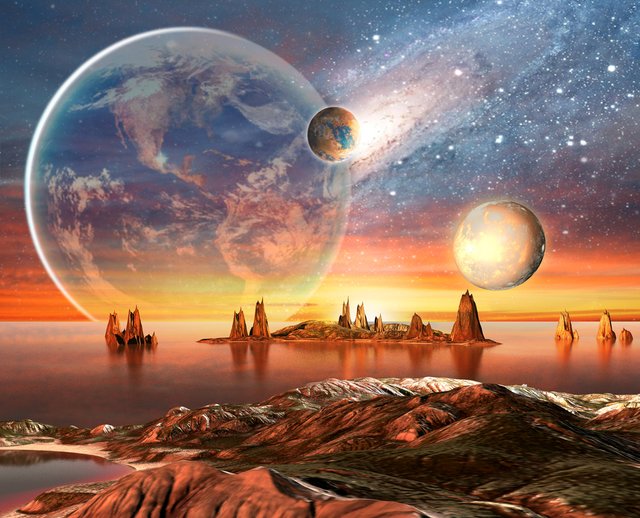Signs of Alien Life Will Be Found by 2025, NASA's Chief Scientist Predicts

Humanity is at the verge of coming across alien lifestyles, excessive-ranking NASA scientists say.
"I assume we're going to have sturdy indications of existence past Earth within a decade, and that i suppose we are going to have definitive evidence inside 20 to 30 years," NASA leader scientist Ellen Stofan said Tuesday (April 7) for the duration of a panel discussion that focused on the distance business enterprise's efforts to look for liveable worlds and alien lifestyles.

"We understand where to look. We realize how to look," Stofan brought in the course of the event, which changed into webcast stay. "In most instances we have the generation, and we're on a route to enforcing it. And so I think we're really on the street."

Former astronaut John Grunsfeld, accomplice administrator for NASA's science undertaking Directorate, shared Stofan's optimism, predicting that signs and symptoms of existence may be discovered exceptionally quickly each in our own solar machine and beyond.
"I assume we are one generation away in our sun machine, whether or not it is on an icy moon or on Mars, and one era [away] on a planet round a nearby superstar," Grunsfeld stated throughout Tuesday's occasion.
Many habitable environments

current discoveries suggest that the solar gadget and broader Milky manner galaxy teem with environments that would aid existence as we understand it, Grunsfeld stated.
as an instance, oceans of liquid water slosh below the icy shells of the Jupiter moons Europa and Ganymede, as well as that of the Saturn satellite Enceladus. Oceans included a whole lot of Mars within the historical past, and seasonal darkish streaks determined on the purple Planet's floor nowadays may be resulting from salty flowing water.

further, NASA's interest rover has found carbon-containing organic molecules and "constant" nitrogen, fundamental substances essential for Earth-like life, at the Martian floor.
Farther afield, observations by way of NASA's Kepler area telescope endorse that nearly each star inside the sky hosts planets — and lots of those worlds may be liveable. certainly, Kepler's paintings has shown that rocky worlds like Earth and Mars are in all likelihood extra common at some stage in the galaxy than gasoline giants along with Saturn and Jupiter.
And just as the solar gadget is awash in water, so is the greater galaxy, said Paul Hertz, director of NASA's Astrophysics department.
The Milky manner is "a soggy vicinity," Hertz stated during Tuesday's occasion. "we are able to see water inside the interstellar clouds from which planetary structures and stellar systems shape. we are able to see water within the disks of particles which are going to end up planetary structures round different stars, and we can even see comets being dissipated in other solar systems as [their] famous person evaporates them."
Looking for life

attempting to find proof of alien lifestyles is a far trickier proposition than identifying doubtlessly liveable environments. however researchers are running gradually closer to that extra involved and formidable purpose, Stofan and others said.
for example, the agency's next Mars rover, scheduled to release in 2020, will look for signs of past existence and cache samples for a likely return to Earth for evaluation. NASA also targets to land astronauts on Mars within the 2030s — a step Stofan regards as key to the look for Mars lifestyles.

"i'm a field geologist; I exit and destroy open rocks and look for fossils," Stofan stated. "those are difficult to locate. So i have a bias that it is ultimately going to take human beings at the floor of Mars — area geologists, astrobiologists, chemists — simply accessible looking for that correct evidence of lifestyles that we are able to convey lower back to Earth for all the scientists to argue about."
NASA is also making plans out a assignment to Europa, which may launch as early as 2022. the principle purpose of this $2.1 billion task can be to shed light on the icy moon's ability habitability, but it is able to also look for signs of alien lifestyles: company officers are thinking about approaches to pattern and study the plumes of water vapor that reputedly erupt from Europa's south polar location.
inside the exoplanet realm, the agency's James Webb area Telescope (JWST), an $eight.8 billion instrument scheduled to release in 2018, will scope out the atmospheres of nearby "fantastic-Earth" alien planets, searching out gases that can have been produced via lifestyles.

JWST will experiment the starlight that passes thru the air of amazing-Earths, which might be greater massive than our very own planet but extensively much less so than gaseous worlds which includes Uranus and Neptune. This approach, known as transit spectroscopy, will probable no longer paintings for potentially habitable Earth-size worlds, Hertz said.
attempting to find biosignature gases on small, rocky exoplanets will instead likely require direct imaging of these worlds, the use of a "coronagraph" to block out the overpowering glare in their parent stars, Hertz introduced.
NASA's ability huge-area Infrared Survey Telescope, which may additionally release in the mid-2020s if given the authentic pass-beforehand, could consist of a coronagraph for exoplanet observations.